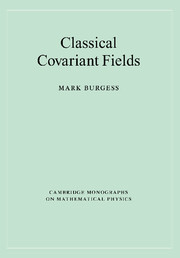
-
The digital format of this book is no longer available to purchase from Cambridge Core. Other formats may be available.
-
Select format
-
- Publisher:
- Cambridge University Press
- Publication date:
- Invalid date
- April 2002
- ISBN:
- 9780521813631
- 9780521675772
- Dimensions:
- (247 x 174 mm)
- Weight & Pages:
- 1.103kg, 552 Pages
- Dimensions:
- (247 x 174 mm)
- Weight & Pages:
- 0.862kg, 552 Pages
You may already have access via personal or institutional login
Book description
This 2002 book discusses the classical foundations of field theory, using the language of variational methods and covariance. It explores the limits of what can be achieved with purely classical notions, and shows how these have a deep and important connection with the second quantized field theory, which follows on from the Schwinger Action Principle. The book takes a pragmatic view of field theory, focusing on issues which are usually omitted from quantum field theory texts and cataloging results which are often hard to find in the literature. Care is taken to explain how results arise and how to interpret them physically, for graduate students starting out in the field. Many physical examples are provided, making the book an ideal supplementary text for courses on elementary field theory, group theory and dynamical systems. It will also be a valuable reference for researchers already working in these and related areas.
Reviews
‘In conclusion, I think that this book can be valuable for graduate students in physics, mainly interested in quantum field theories and particle physics, who will appreciate an exhaustive description of the classical foundations of such theories.’
Source: Zentralblatt MATH
Contents
Metrics
Altmetric attention score
Full text views
Full text views help Loading metrics...
Loading metrics...
* Views captured on Cambridge Core between #date#. This data will be updated every 24 hours.
Usage data cannot currently be displayed.
Accessibility standard: Unknown
Why this information is here
This section outlines the accessibility features of this content - including support for screen readers, full keyboard navigation and high-contrast display options. This may not be relevant for you.
Accessibility Information
Accessibility compliance for the PDF of this book is currently unknown and may be updated in the future.


